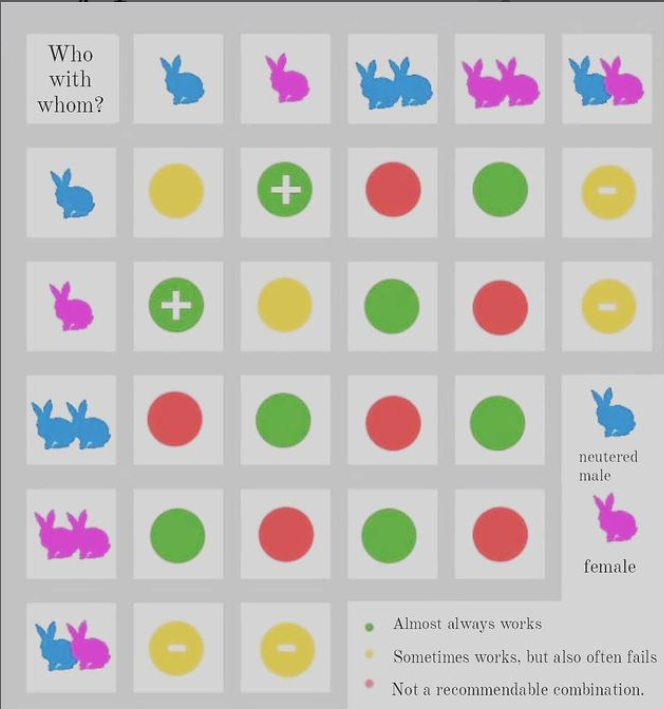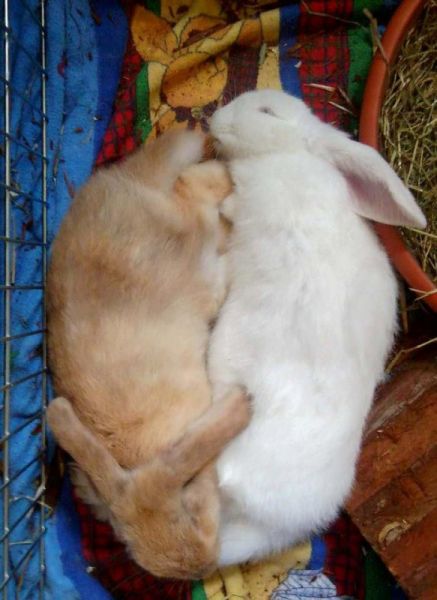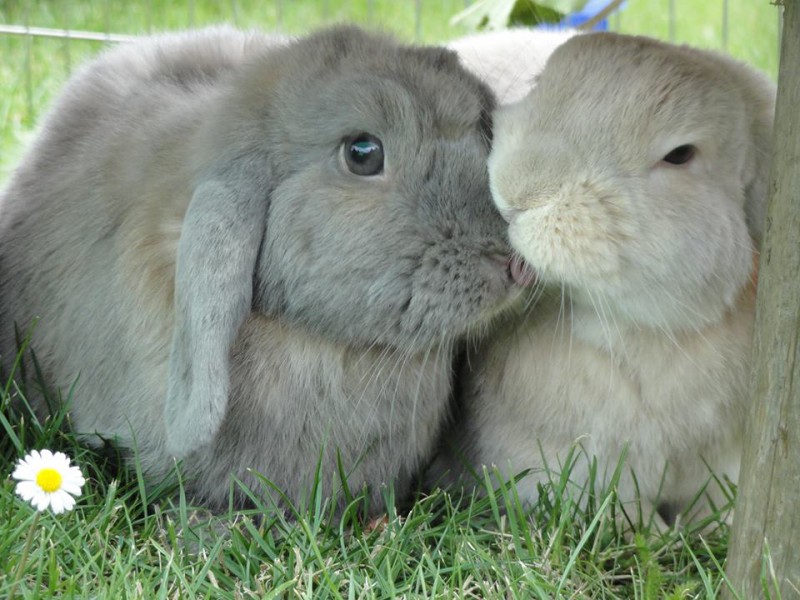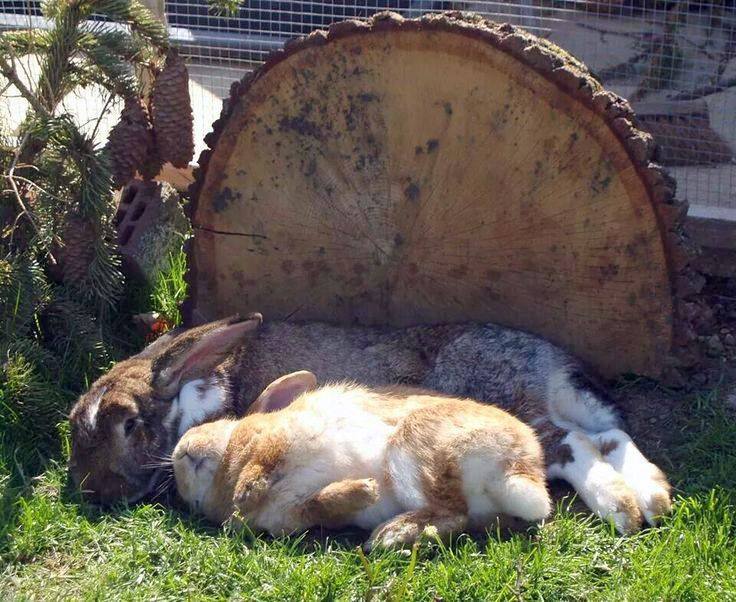Contents
Character

For those unsure about matching personalities, it’s advisable to keep a pair (neutered buck and doe) since they get along regardless of their individual characters. rabbitcuddlingmickey The most significant factor influencing the success of bonding is the personality of each rabbit and, consequently, their behavior.
Bonding a pair with one aggressive, dominant rabbit and one shy, submissive rabbit can sometimes be quickly successful, as the submissive one may submit while the dominant establishes its position. However, it can also fail, especially if the dominant rabbit attacks the submissive one persistently over days and continues to be disruptive even after weeks. Two shy, submissive rabbits often get along without fights during bonding. On the other hand, two extremely dominant rabbits, unwilling to relinquish their alpha status under any circumstances, are often incompatible, especially with same-sex (also dominant) rabbits. Therefore, the rule always stands: Only one alpha rabbit per group, and if a rabbit has been an alpha before, it should be allowed to continue in that role in the new group.
Most rabbits are neither alpha nor extremely submissive. Such rabbits usually get along quite well together.
Genders
The bonding of a A neutered male and a female is usually unproblematic and works almost every time.
Two rabbits: Cross-gender rabbits (neutered buck & doe) are particularly compatible, while same-gender rabbits usually engage more intensely in establishing dominance and only get along if they have plenty of space and perhaps have been raised together from an early age (early neutering of males is recommended). Same-gender rabbits can have serious fights and cause harm during puberty (around 6-10 months), especially with unneutered bucks, leading to sudden, severe, or even deadly confrontations. If keeping two same-gender rabbits, it is advisable to introduce another cross-gender rabbit.
If two unneutered bucks are fighting or causing wounds, it is recommended to have them neutered as quickly as possible. During neutering, it is important for them to wake up from anesthesia together and then move to a neutral enclosure together. If possible, a female rabbit should be introduced as well. This approach helps them reestablish their bond.
Rabbit groups: In larger groups, it’s best to have approximately an equal number of males and females. If opting for an odd group number, it’s advisable to choose one more rabbit from the gender that has previously interacted most harmoniously. Often, a surplus of females is more compatible than a surplus of males. Females may chase and squabble with each other, while males are often harmonious but can engage in serious fights if they do clash. However, every rabbit is different, and group housing requires a lot of experience from the owner, keen observation, and sensitivity when assembling the group. Not every rabbit is suited for large groups! Some prefer to live as a pair. The success of a group usually depends on how well same-gender rabbits get along with each other. Therefore, the easiest way to form a group is by introducing already harmonious females with males that are mutually compatible.

Socialization

Rabbits that grew up in a group or lived with other rabbits for an extended period exhibit the best social behavior.
Rabbits that were well-socialized, meaning they grew up in a large group with rabbits of different genders and continued to live there, are advantageous. Single rabbits or those living alone as young ones usually need catch-up in their interactions with other rabbits. In shelters where rabbits are housed in groups, the caregivers can often provide insights into the behavior of individual rabbits within the group, helping you find a compatible dwarf rabbit.
Age Rabbits of similar ages generally get along best. Young rabbits need a playmate of the same age, while older rabbits prefer a calm cuddle buddy. Older or sick rabbits are often bullied by younger ones. group-cuddle Depending on the size of the enclosure, residents should have similar activity levels. A senile, calm rabbit might feel disturbed by overly energetic youngsters and would prefer a calm cuddle partner. Young rabbits are happier with another active rabbit in the group. Age differences can become a problem when a rabbit shows signs of advanced age. Older rabbits may sometimes be heavily bullied by very young ones, even if they were happily together in the years before. However, in large groups with ample space, a mix of ages is possible, with younger rabbits invigorating the group while older ones provide necessary calm and order.
Planning: Continuing or Ceasing Rabbit Keeping?
- If you intend to continue keeping rabbits, you can introduce two younger cross-gender rabbits (around 1.5 years old) to the senior rabbit. This way, he has company, and the younger rabbits won’t be bored. If he passes away, they cope with the loss better than a solitary rabbit, and you can calmly look for a third rabbit without one languishing in loneliness.
- If you plan to stop keeping rabbits in the long run, it’s helpful to gather information on how to cease keeping them without having a rabbit in solitary. This way, you can select the new rabbit appropriately: Ceasing Rabbit Keeping Without Solitary Confinement
Juveniles (pre-sexual maturity or under approximately 16 weeks) cannot defend themselves yet. Therefore, they can be severely harmed during bonding with sexually mature rabbits. Young rabbits should only be introduced (preferably initially outside the enclosure, beyond the territory) if they are accepted without conflict. Otherwise, they must be separated immediately and reintroduced around 16 weeks old when they begin to defend themselves. Juveniles pre-sexual maturity can generally be easily bonded with each other without issues.
Neutered or Unneutered?

Male rabbits (bucks) must be neutered as a general rule. Females are spayed for medical reasons.
Two unneutered males can cause severe injuries to each other, even if they were inseparable as juveniles. Therefore, neutering is indispensable to keep them in a socially appropriate manner. Females are not spayed for compatibility reasons but only when medically necessary. It is worth mentioning that, especially in groups that are not entirely harmonious but function reasonably well, neutering a group member can result in a decrease in rank. While this may sound positive initially, it can often become a problem. If there was a clear hierarchy before, it might happen that the neutered rabbit holds the same rank as the subordinate one, and thus, the hierarchy is „never resolved.“ Many animals are also so affected (similar to a disease that causes a decrease in rank) that they „fight to the death“ and refuse to accept their subordinate status. This can lead to severe bite injuries. In other cases, the group composition may improve due to neutering. However, foreseeing this outcome is not possible, especially since behavior is also influenced by other factors (illness/pain, age, etc.), which are not eliminated by neutering, and of course, by the individual character itself. Only hormonal issues can be addressed by neutering. There is also the option of a trial chemical neutering through a chip. This can help determine whether the behavior is hormonally driven or has other causes.
How many rabbits?
Pairs of rabbits are uncomplicated, and even groups of three often work well. Larger groups require experienced hands. Pairing two rabbits is straightforward. Introducing four or more rabbits to a group requires experience and is not recommended for beginners. It’s advisable to start with two or three rabbits and consider expanding the group after gaining experience with these animals. Groups between four and about 12 rabbits can be problematic. If the group is significantly larger, it becomes easier again. Therefore, introducing the eighteenth rabbit might not be problematic. However, this strongly depends on the group. It can be advantageous to introduce two rabbits to the group so that not all established rabbits focus on the new one, distributing conflicts more evenly.
Handicapped, chronically ill, and old rabbits

These rabbits are often, but not always, bullied by healthy rabbits, especially if the illness affects their general well-being. Therefore, they should be kept separately among themselves. Snuffly rabbits and those with minor limitations are usually not affected. Keeping sick or weakened rabbits together is unproblematic, social, and cuddly. Solitary housing is not a solution!
The following factors have no influence on compatibility!
- Rabbits form friendships regardless of size; a Giant German can be friends with a small rabbit, and vice versa.
- The breed also does not determine whether rabbits get along with each other.
- Lop-eared and upright-eared rabbits can get along just as well, as can groups with pure lop-eared or upright-eared rabbits.




















